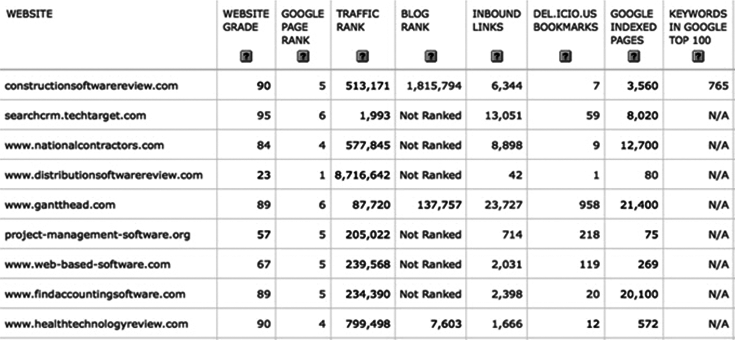Chapter 16
Watching Your Competition
We recently spent some time with Jim Cash. Jim is a former professor at Harvard Business School and now is a professional board member, serving on the boards of Microsoft, GE, Walmart, Chubb, and the Boston Celtics, among others.
We asked Jim to tell us about some of the world-class CEOs with whom he has worked. He mentioned a few attributes about them, but the one that stuck out was that the top CEOs were all a little bit paranoid. They were always watching what their competitors were doing and were all leery of potential upstarts that could do damage to them. What Jim had to say is consistent with what legendary Intel CEO Andy Grove said in his book titled Only the Paranoid Survive.
The web is a flattener of all marketplaces—it is the ultimate meritocracy. Because the web makes it so much more efficient to spread ideas, it poses a great opportunity for upstarts with unique new products or services, so you should be more paranoid now than you have ever been because you have never been so vulnerable!
Tools to Keep Tabs on Competitors
On the flip side, it is easier than ever to track how your competition is doing on the web if you know what you are doing. Here are six different ways you can track yourself relative to your competitors:
- Website Grade—Go to Grader.com and run your website alongside your competitors' websites to see how well you do. Pay special attention to upstart competitors who might be more focused on leveraging the web than some of the more traditional players.
- Inbound Links—Look on the Grader report and pull out the number of links for you and your competitors. An increase in the number of links to a site can indicate that a competitor is getting more traction with its products.
- Facebook Fans—Go to Facebook.com and see the number of fans your company's website has relative to your competitor's website. You will have to search around to find the company page in Facebook. This number is worth tracking over time—if your competitor starts to gain a lot of fans, then it means their customer loyalty is increasing. This might mean it is going to get harder to steal customers from them, forcing you to focus on non-consuming parts of your market.
- Compete—Go to Compete.com and compare their estimate of the traffic your site is getting versus your competitors.
- SiteAlerts—Go to SiteAlerts.com and see what number of mentions you're getting on the web, and what keywords are driving search traffic. Compare that to your competitors.
- Buzz—Go to Google and do a search on “your brand” (in quotations) and look at the number of results in the upper right-hand corner. Do the same for each of your competitors. The number of results shows the number of pages on the web where the brand is mentioned. This metric is worth tracking over time as it will let you know how your “buzz” is relative to your competitors'. You can do the same thing in blogsearch.google.com to see how your buzz is going relative to your competitors in the blogosphere.
Tracking Your Progress
The following is a snapshot of the tool we use to track how we are doing on these important metrics relative to our competitors (see Figure 16.1). We recommend you track your traditional competitors, upstarts, and companies you consider as alternatives to your product.

Figure 16.1 Competitor Grader
It is important to get a baseline of how you are doing relative to your competitors once, but even more important to get a baseline of how you are doing relative to your competitors over time. (See Figure 16.2.) You need to look at each of these metrics and watch for big moves along any of these dimensions. As mentioned earlier, the web can give competitors a big advantage if they know how to use it.

Figure 16.2 Delicious Bookmark Comparison Over Time
Inbound in Action: TechTarget
TechTarget was founded in 1999 and went public in 2007. TechTarget is an expert at using inbound marketing to generate leads that it sells to technology companies. They create topic-specific websites with remarkable content that draw people in, and develop leads that they then sell to technology companies. According to Greg Strakosch, founder and CEO of TechTarget, “Our use of inbound marketing techniques has been a key ingredient in our success thus far.”
Like a lot of successful companies, they are very clever about how they analyze their competition and how they analyze each site relative to that of their peers. Figure 16.3 shows how they lay it out for themselves.

Figure 16.3 TechTarget Comparison Chart
For each one of those web metrics, they then track how they are doing versus their competitors and peers over time, as is shown here, where they look at their Website Grade for constructionsoftwarereview.com (moved from last to first) relative to their competition over time (see Figure 16.4).

Figure 16.4 TechTarget Historic Comparison
They also like to analyze how they are doing relative to their competition/peers in Google organic rankings, and keep track of it in the following tool (see Figure 16.5).

Figure 16.5 TechTarget SEO Comparison
Strakosch commented, “All of this competitive information is used to keep us abreast of how we are doing against the competition. It is also used in our sales cycle to differentiate us from the competition.”
To Do
- Be more paranoid.
- Run your site through the different tools described earlier.
- Track the results in a spreadsheet or application.
- Track the results over time and check on a monthly basis.
- _________________________________________________________
- _________________________________________________________